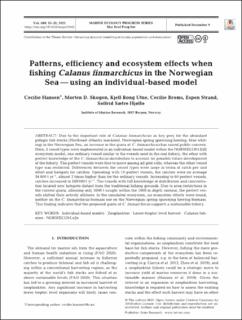| dc.contributor.author | Hansen, Cecilie | |
| dc.contributor.author | Skogen, Morten D. | |
| dc.contributor.author | Utne, Kjell Rong | |
| dc.contributor.author | Broms, Cecilie | |
| dc.contributor.author | Strand, Espen | |
| dc.contributor.author | Hjøllo, Solfrid Sætre | |
| dc.date.accessioned | 2022-03-02T11:41:31Z | |
| dc.date.available | 2022-03-02T11:41:31Z | |
| dc.date.created | 2022-02-10T13:23:35Z | |
| dc.date.issued | 2021 | |
| dc.identifier.citation | Marine Ecology Progress Series. 2021, 680 15-32. | en_US |
| dc.identifier.issn | 0171-8630 | |
| dc.identifier.uri | https://hdl.handle.net/11250/2982437 | |
| dc.description.abstract | Due to the important role of Calanus finmarchicus as key prey for the abundant pelagic fish stocks (Northeast Atlantic mackerel, Norwegian spring spawning herring, blue whiting) in the Norwegian Sea, an increase in the quota of C. finmarchicus has raised public concern. Here, 2 vessel types were implemented in an individual-based model within the NORWECOM.E2E ecosystem model, one ordinary vessel similar to the vessels used in the real fishery, the other with perfect knowledge of the C. finmarchicus distribution to account for possible future development of the fishery. The perfect vessels were free to move among all grid cells, whereas the other vessel type was restricted. Differences between the vessel types were large in terms of catch per unit effort and hotspots for catches. Operating with 10 perfect vessels, the catches were on average 54000 t yr-1, almost 3 times higher than for the ordinary vessels. Increasing to 60 perfect vessels, catches increased to 349000 t yr-1. The vessels with full knowledge of distribution and concentration located new hotspots distant from the traditional fishing grounds. Due to area restrictions in the current quota, allowing only 3000 t caught within the 1000 m depth contour, the perfect vessels shifted their activity offshore. In the simulated ecosystem, no ecosystem effects were found, neither on the C. finmarchicus biomass nor on the Norwegian spring spawning herring biomass. This finding indicates that the proposed quota of C. finmarchicus supports a sustainable fishery. | en_US |
| dc.language.iso | eng | en_US |
| dc.title | Patterns, efficiency and ecosystem effects when fishing Calanus finmarchicus in the Norwegian Sea—using an individual-based model | en_US |
| dc.type | Peer reviewed | en_US |
| dc.type | Journal article | en_US |
| dc.description.version | publishedVersion | en_US |
| dc.source.pagenumber | 15-32 | en_US |
| dc.source.volume | 680 | en_US |
| dc.source.journal | Marine Ecology Progress Series | en_US |
| dc.identifier.doi | 10.3354/meps13942 | |
| dc.identifier.cristin | 1999969 | |
| dc.relation.project | Norges forskningsråd: 234341 | en_US |
| dc.relation.project | Havforskningsinstituttet: 14809 | en_US |
| dc.relation.project | Norges forskningsråd: 299554 | en_US |
| dc.relation.project | EC/H2020/727890 | en_US |
| cristin.ispublished | true | |
| cristin.fulltext | original | |
| cristin.qualitycode | 2 | |
